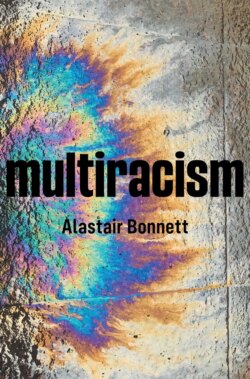Читать книгу Multiracism - Alastair Bonnett - Страница 16
The Western Gaze
ОглавлениеI first became aware of racism at school, more than forty years ago, where every day brought another fight between racist skinheads and Asian, Black, Jewish, and White Christian-heritage anti-Nazi children. That makes it sound almost heroic: it wasn’t, it was horrible. And my description imposes labels that hardly fit the memory. It was a boys’ comprehensive (i.e. state) school and we called each other by our second names: it was Flack, Macfarlane, Silver, Bonnett who ran, or walked by, or stood their ground. The alliances and feuds were messy but racism soaked everything and I guess that is why I thought about it so much and why, in one way or another, I’ve been thinking about it ever since. As my studies have broadened, and become more international, they have brought in doubts. What right does a White Englishman have to sit in judgement on racism in China? Or Sudan? Or Turkey? It is a question that hovers over this book because the Western history of racism is entangled with the history of how and why White people have the power to represent the world and be listened to. Moreover, as books such as Reni Eddo-Lodge’s Why I’m No Longer Talking to White People About Race illustrate, knowledge of race – if not ethnicity – and racism is often associated with the direct experience of being racialized as non-White. However, Eddo-Lodge’s argument is not that White people should walk away from the topic but that they should engage harder and listen.
The way I engage harder and listen may appear paradoxical and controversial since, to some extent, it shifts ‘our’ gaze outwards. A misuse and misreading of Multiracism would be to claim that it gives credence to the idea that racism is not a Western problem. It does nothing of the sort but this kind of worry helps explain why there are so few studies of racism outside the West. In his monograph on cultural racism in China, Kevin Carrico writes that in ‘the field of anthropology, the denunciation of the colonial past and the discipline’s role therein has produced an environment in which critique can seemingly only be applied to “the West”’.83 Similarly, in his exploration of the impact of ideas of racial whiteness in Turkish history, Ergin reports that his research was met with consternation by nationalist Turks. For them the duty of Turkish scholars is to burnish the image of the nation and the topic of racism is ‘an insulting chapter in the past’ that is best ‘forgotten’.84 Yet Ergin was not daunted and he is not alone. Despite the considerable challenges, even dangers, they sometimes face, critical scholars from across the world are increasingly part of a debate on racism that is comparative and transnational, dissecting multiple routes and roots and drawing into conversation but also destabilizing notions of ‘Western’ and ‘non-Western’. Cheng connects the need to think about racism ‘not just in a binary framework of the West and non-West or between whites and non-whites’ to the ‘fresh dynamics brought about by the new reality of globalization’ as well as the new appetite and need to appreciate the relationship between racism and ‘ethnic consciousness, cultural tradition (especially religion), nationalist sentiment, xenophobia’.85 The bibliography of this book is a compendium of Asian, African, and Western experts dissecting racism. It reflects a new transnational geography of critical scholarship. Multiracism aims to be part of this global conversation.
